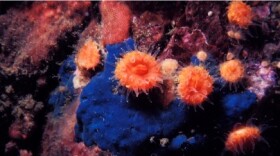A storefront in Seattle’s South Lake Union neighborhood has been the site of an ever-evolving sculpture, of a tree turned on its side. About a year ago, the site became a hub for a new kind of collaboration with one of the city’s most productive public artists.
Sculptor John Grade and his supporters at the Mad Art Gallery invited hundreds of people in, to help assemble Middle Fork. It’s now a 40-foot long model of a Western Hemlock, suspended inside a large gallery space that’s just down the block from a Tesla Motors showroom and across from the Seattle offices of Microsoft.
The artist used volunteers to glue his latest piece together from hundreds of tiny salvaged blocks of wood. Many of them had to learn how and some worked side by side with Grade. Yet, despite all the effort, Middle Fork will ultimately go back to nature two years from now.
When you enter Mad Art and see the sculpture, which is suspended about 4 feet off the ground, it’s hard to believe something so beautiful could be allowed to just fall apart on the forest floor a couple of years from now. The tiny blocks (made by Grade and his assistants from reclaimed cedar) have been sanded to into a shimmering and intricate surface.
But he says giving It back to nature has been part of his plan from the beginning.
This giant hollow structure is designed to go back to the forest where it came from and decompose. It’s expected to moss over and slowly decay.
“It’s actually a skin. So, we cast the outside of the tree - and then took those molds off the tree and then built our skin around the outside of those molds. So, in a way I think of it as an ode to a year in the life of the tree,” Grade says.
The thickness of the skin represents about a year or two years of growth, he says.
Creating that temporary shell was labor intensive. Grade hired a team of assistants and arborists to climb a 140-year-old Hemlock in a forest in North Bend.

Working at nearly 90 feet off the ground, they wrapped the tree’s limbs in thick foil, then made plaster casts that they carefully peeled off and lowered to the ground, before transporting them back to Seattle.
“So it was a really amazing experience,” Grade says. “To be up in a tree canopy and very carefully taking a mold of these surfaces, finding small surprises, but just immersing yourself. And my thought was: how can I take that experience and bring it to people who might want to participate in the project?”
They recruited all kinds of volunteers -- even some people who just wandered in off the street -- pretty much anyone who had time to help build his creation was allowed to join in.
And Grade says the location, in Seattle’s busy and tech-heavy South Lake Union neighborhood, provided an interesting contrast -- because it took untold hours to piece this thing together -- forcing his volunteers to slow down.
“Because for somebody to work on a little section of the sculpture (that) might be 6 x 9 inches, would take about 4 hours,” says Grade, explaining that the process involved very carefully looking at the mold and then needing to choose wood pieces and custom cut some parts, “all to arrive at greatest fidelity they could to that mold.”

All kinds of people showed up, from a 98-year-old retiree to a bus driver, a doctor, a lawyer, and several groups of students and tech workers, Grade says --a couple hundred total.
People invested varying amounts of time, with some coming back for days on end. And the community’s involvement wasn’t limited to those who had a lot of time to give. Others just watched it grow through the storefront windows, especially during the lunch hour.
“We try to do things that inspire us creatively and we knew that this installation was here so we just decided to come over,” said copy writer Erin Reitz. She’s part of a web design team for fashion company Tommy Bahama, which has offices down the block from the gallery.
Her colleague Sean Carney said seeing it finished, as well as just watching the process of the communal sculpting over time, definitely has made a lasting impression.
“I’ve never seen a tree from this perspective,” Carney said. “It’s very odd to see – you’d probably be, what, 75 feet in the air, looking down – that’s so cool!”
Yet, despite all the hard work and admiration, no one’s complaining about the plan to abandon it and let it disintegrate.

Grade says many people like the way he challenges notions of art as something precious. He thinks that’s part of why Middle Fork has seen so much buy-in from the public.
"I think it makes it a different dynamic when you’re giving of your time toward something that’s not then this economically-driven model. Instead you know it’s just going to go back to where it came from,” Grade said.
But before that happens, Middle Fork will travel to the Smithsonian, to join a group exhibition with other contemporary works in a “cabinet of wonders.” Among those included is a piece by monument designer Maya Lin.
He’s also working on a companion piece that’s a much smaller work, modeled after a tree of the same age that he found by traveling as far north as he could, in the Arctic. The Smithsonian exhibit begins November 13th.
---------------------
You can see “Middle Fork” in Seattle for two more days. The display at Mad Art Gallery continues till 5 o’clock on Friday May 8th.














